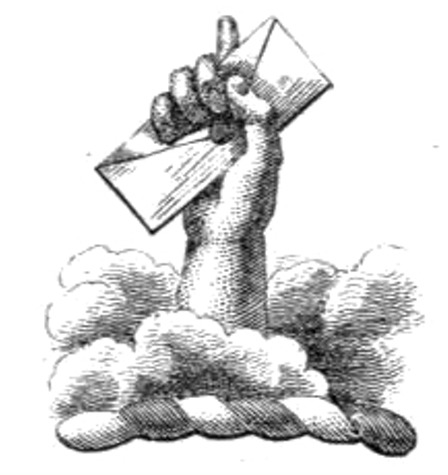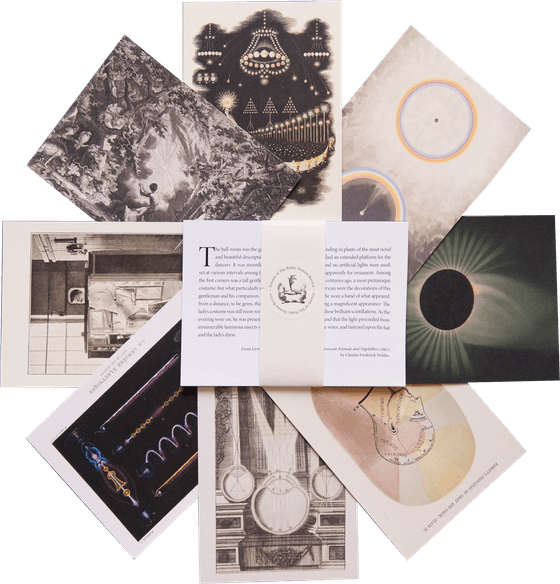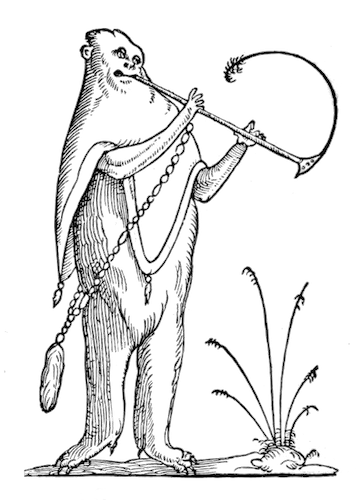
As Bright as a Feather Ostriches, Home Dyeing, and the Global Plume Trade
In the 19th century, dyed ostrich feathers were haute couture, adorning the hats and boas of fashionistas on both sides of the Atlantic. Whitney Rakich examines the far-reaching ostrich industry through a peculiar do-it-yourself-style book: Alexander Paul’s The Practical Ostrich Feather Dyer (1888), a text interleaved with richly colored specimens.
May 7, 2025
A selection of feathers from Alexander Paul’s The Practical Ostrich Feather Dyer (1888) — Source.
Every few pages of The Practical Ostrich Feather Dyer (1888) offers up a surprise: clusters of dyed ostrich feathers, arranged like technicolor sea anemones. The volume contains forty-eight astonishing examples, on twelve plates of four. Between the samples are instructions for reproducing each color exactly, with notes for adjustments that help the dyer brighten or dull the hue. The author, Alexander Paul, draws on his experience as a teacher of “the art of Ostrich Feather Dyeing, as simplified and perfected by me during years of hard work and research”.1 It is a volume of best practices, and one that quietly honors hard work, precision, and an egalitarian entrepreneurial spirit. Paul guarantees the integrity of his work in the preface, offering $1,000 to anyone who can prove that the instructions provided do not yield the promised colors. And what colors they are: Lemon, electric blue, ruby, cardinal, scarlet, heliotrope, and lilac. Plum, gendarme blue, bog green, Russia green, and ordinary green. Mushroom and magenta. Prune and navy. Pearl gray, amaranth, salmon, bronze. Lavender, olive, orange, moss. Bismarck brown, green pea, terracotta, seafoam, old-gold, corn. Coffee, chocolate, drab both felt and plain. Black, ecru, silver gray, and white.
Domesticated Ostriches, Global Feathers
In their freshly plucked state, ostrich feathers are neither luxurious nor glamorous. But then, neither are ostriches really. They weigh three-hundred pounds, can be nine feet tall, and have a penchant for dust baths. They can run up to forty-five miles an hour, and have a kick powerful enough to shatter a human eye socket or disembowel a grown man. While they prefer plants, they will also eat small animals, insects, and carrion if desperate. In the wild, they often strip off clumps of feathers to rid themselves of lice. They are independent, single-minded, and had long fended off any attempts at large-scale domestication, which only made their plumes more valuable.
Ostriches and their feathers had long been prized throughout Britain and America. In April 1745, for example, the Derby Mercury in Derbyshire encouraged readers to visit “Two large Beautiful Ostriches, Alive, (Cock and Hen), Lately Arriv’d from Santa Cruz, in Barbary”.2 Praised in the article for their long legs and necks, the advertisement states “they are cover’d with Feathers, which have an agreeable Mixture of Black and White, and are of great Value; the feathers on their Wings and Tails are of a beautiful White, and the richest plumes are made thereof.” Dry goods sellers valued ostrich feathers as highly as garnets and violins. And a lost feather was a matter of urgent concern: a 1768 Maryland Chronical classified from Fredericktown offers a reward of one dollar for the return of a large black ostrich feather, “lost between John McGill’s and this town”.3
Dyed ostrich feathers were used in many applications, in fashion from hats to boas to dress trimmings, in quilts and for lining parkas, and especially in funerary art. Eight enormous sprays of flat-black ostrich plumes topped President Lincoln’s hearse, and wealthy Victorians mourned with black ostrich feather wreaths on their front doors. It is no surprise then that Paul spends extensive time discussing black, “the most stable and important of all colors”, which “improves with age; and, instead of fading, the black will grow more intense.”4
Advertisement for plumes from the 1909 Cawston Ostrich Farm Souvenir Catalogue — Source.
 Scroll through the whole page to download all images before printing.
Scroll through the whole page to download all images before printing.Portrait of American actress and singer Lillian Russell wearing a hat with plumes, ca. 1898 — Source.
-edit.jpg?width=1200&height=850) Scroll through the whole page to download all images before printing.
Scroll through the whole page to download all images before printing.Portrait of a German woman called Wally, surname unknown, wearing a hat with plumes, ca. 1909 — Source.
Photograph of Holborn, London’s Ostrich Feather Emporium., ca. 1900 — Source.
Because of the growing demand for feather stock globally, the turn of the twentieth century was a particularly tough time to be a bird. Ostriches, egrets, herons, great auks, and scores of other species were hunted — sometimes to extinction — for their plumes. In 1915, plumes sold for $32 an ounce, the same price as gold.5 Raw feather stock of all varieties was one of the most prized commodities in the growing international economy. When the Titanic sank in 1912, among the most lamented lost cargo was a “consignment of £20,000 of ostrich feathers”.6 But the killing was unstainable: an estimated 300 million birds of various species had been killed for the fashion trade since the mid-1800s, at the rate of 5 million birds a year. Being flightless, enormous, and living up to seventy years in captivity, ostriches presented a potential opportunity for domestication and sustainable plume harvesting that appealed to both feather buyers and conservationists.
The Practical Ostrich Feather Dyer thus marks a unique moment of collision between conspicuous consumption at any cost and a more humane and sustainable approach to global commerce. The domesticated ostrich, it was argued, would not be harmed by the selective plucking of feathers; in fact, it would be “a happy and contented bird,” and “an eminently useful denizen of our soil”.7
“Plucking the beautiful plumage from the famous biped of the desert, South Africa”, 1900 — Source.
Harvesting ostrich feathers at Edwin Cawston’s South Pasadena ostrich farm, ca. after 1896 — Source.
While the fascination with ostriches has a long and global history — ancient Egyptians kept them in small herds for meat and eggs; ancient Mesopotamians used their eggshells as drinking vessels; the Old Testament mentions ostriches no fewer than three times — it was not until the mid-nineteenth century that farmers made a serious attempt to keep the birds specifically for their plumage and not as a food source. In 1878, Anthony Trollope described a new South African process of sustainable feather harvesting in Illustrated London News, explaining that feathers were not pulled from the entire bird at once, but were instead selectively clipped near the body in small batches every seven months. The dry and shriveled quill was removed at a later date, in order to minimize pain for the bird.
In order to meet plume demand, there was much interest in domesticating ostriches in the United States specifically, since the climate of the American South and West aligned well with wild ostrich habitats. If successful, it would not only be more convenient than shipping ostrich feathers by sea, but also enormously lucrative, as Afrikaner farmers in South Africa saw a nearly 5000% return on the original investment in eight birds. Yet, Paul explains, not all ostrich farms were equal; while those in South Africa produced feathers of the best quality, he was deeply skeptical about the idea of ostrich farms in California. A Philadelphia man himself, he seems nonplused by the whole idea of California as a suitable location for ostriches, or possibly for anything at all. While he believed the birds would survive, he was doubtful about the quality of their plumage, for “there is scarcely enough substance in ten-penny nails or doorknobs to fatten an ostrich on.”8
At first, it looked like Paul’s skepticism about American ostrich farming was well-founded. Under the care of South African ostrich farmer Dr. Charles J. Sketchley, a herd of 200 California-bound ostriches boarded a ship in Cape Town in 1882; by the time the birds arrived in New York via Buenos Aires, ninety percent had perished. The surviving birds were then transported via rail from New York to Anaheim but were so unwell that feather harvesting had to wait. But all was not lost. Just as Sketchley was overseeing the demise of nearly his entire herd, his competitor E. J. Johnson organized the American Ostrich Company and brought twenty-three healthy birds to New Orleans in 1884. Thanks to his careful attention to their needs and meticulous study of their habits before their journey, all twenty-three survived and were taken to Fallbrook, California, near San Diego, where they would flourish over subsequent decades.
Cover page of a souvenir catalogue from the Cawston Ostrich Farm, which ran from 1886 to 1935 — Source.
“At the Ostrich Farm”, photograph by an uncredited photographer from an album titled “Tourist Album: Mexico, Arizona, California, Colorado and Utah”, 1902 — Source.
Other farms soon followed throughout the American West, as well as in Arkansas and Florida. The farms became sites for bird husbandry and study, as well as tourist locales — the sight of an ostrich was and will always be irresistible. In these captive conditions, much was learned about ostrich habits including the fact they do not bury their heads in the sand, and that the males (and never the females) incubate their clutches, sometimes at a great cost to the male’s wellbeing. Indeed, ostrich ranches provide us some of the most peculiar and delightful tourist ephemera of the time, including photographs of people riding ostriches, sitting sidesaddle or straight, or being drawn in ostrich-carts as if by some feathered Clydesdale.
-edit.jpg?width=1200&height=850) Scroll through the whole page to download all images before printing.
Scroll through the whole page to download all images before printing.Picture postcard of a man riding an ostrich at the Cawston Ostrich Farm, after 1886 — Source.
 Scroll through the whole page to download all images before printing.
Scroll through the whole page to download all images before printing.Picture postcard of a man riding an ostrich at the Cawston Ostrich Farm, after 1886 — Source.
An ostrich-drawn cart at the Cawston Ostrich Farm, ca. 1919 — Source.
The domestication experiment was a success, to the delight of feather dyers, investors, and naturalists alike. As Berthold Laufer, Curator of Anthropology at the Field Museum in Chicago, later noted in his 1926 monograph on ostrich egg-shell cups:
The scientist is gratified at the domestication of the ostrich, because it supplies the demands of the feather trade and will therefore lessen or ultimately stop the reckless slaughter of wild ostriches, and let us hope, also the killing of song-birds formerly sought for their feathers. It will enable us, further, to obtain an accurate account of the bird’s life history and habits and render it justice and correct the numerous errors to which the ill-founded fables of past centuries have subjected it. . . . The domestication of the ostrich is a positive contribution to the progress of humanity and humanness, and may be designated one of the great achievements of modern civilization.9
“Do Not Interrupt Operations”: DIY Feather Dyeing
The Practical Ostrich Dyer provides detailed guidance on one of the most important trades of its time, seeking to make the particulars of feather-dyeing as affordable, reproducible, and efficient as possible. As with wool, turning a natural fiber into a textile fiber — especially a purely decorative one — is a matter of extensive cleaning and processing.
The virgin feathers range from a dirty white to a deep black but are mostly a drab brown like the animal’s native savannahs. The tiny hair-like feathers are known as barbules, which line the frond-shaped barb; together these make a plumule. A cluster of plumules is known as a flue. (The most desirable ostrich feather is that of the North African or Barbary ostrich, with parallel flues of barbs known as “double-floss”.) For dyeing flues any color, preparation of the raw feathers is the same. First prepare a bath of starch and lukewarm water in order create an even surface for the dye and protect the barbs from damage, and then “enter your feathers” into clear water again.10 All feathers must be run through scouring and bleaching baths, “first in two or three warm waters and then in cold water”.11 From there the feathers must be squeezed first through a closed hand, then “between several laps of clean dry muslin . . . with a smart pressure over it”.12 Once starched and cleaned, the feathers take dye easily. Dyeing takes place in small batches, and Paul provides careful step-by-step instructions for each color and shade, along with various color-correction tips if the dye turns too dark or is too light, or if the dyer is “careless” and inattentive. Once the desired color is achieved, the feathers must then be “well drained, centrifugated or whizzed, and starched and dried” by hanging them individually up in the sun.13 The flues can even be stripped of their colors and redyed — or “renovated” — as the occasion requires.
Photograph by Cornelis Johan Hofker of ostrich feather dyers in Amsterdam, 1919 — Source.
“An ostrich feather merchant’s shop in Omduran [Sudan]”, ca. 1910 — Source.
“Technicalities and high-sounding phrases”, Paul says in his preface, “have no place in this work”.14 He sets his everyman technique of feather-dyeing against the secretive and proprietary practices of established dyehouses. During his time learning the trade in France, he experienced this control firsthand, and the French dyers “impressed me as being the most egotistical mortals”, whose reluctance to embrace new techniques and share their production process irritated him even more.15 In response, Paul sheds light on all the secrets of the trade, assuring the reader that no knowledge of chemistry is required at all. Paul writes conversationally, if somewhat formally, on not just feather dyeing, but also about life and craft more generally: “Do not interrupt operations, if it can be avoided, but do the work rapidly and continuously, without pausing. Keep every utensil scrupulously clean.”16
No matter how clean the instruments, dyeing on any scale was not without serious health and environmental risks. The late 1800s saw the rise of a spectacular number of aniline synthetic dyes of wildly varying toxicity, which began accidentally in 1856 when, in an attempt to synthesize quinine to treat malaria, William Henry Perkin precipitated a black-violet coal-tar powder that led to the dye known as mauvine purple (or “Perkin’s mauve”).17 To make these synthetic dyes color-fast, further chemical additives were required, which then ran off into the water supply; to this day, dye-making for fashion is responsible for twenty percent of global water pollution. The feather-dyeing craft did and still does involve intimate and prolonged contact with various dangerous acids and bases, and the late 1800s was an era of few regulations and incomplete knowledge about the health effects of chemical exposure. Paul was only able to practice his craft to the degree of precision allowed by the instruments of the time, including thermometers and percent-by-weight acid baths. Without modern measuring equipment, the dyer’s ultimate tools were his senses. Much to the contemporary reader’s horror, Paul advises adding enough sulfuric acid “to give the [dyebath] water a very slight, scarcely perceptible acidic taste”.18
 Scroll through the whole page to download all images before printing.
Scroll through the whole page to download all images before printing.Ideal dye shop layout from Alexander Paul’s The Practical Ostrich Feather Dyer (1888) — Source.
 Scroll through the whole page to download all images before printing.
Scroll through the whole page to download all images before printing.Steaming kettle and curling knife from Alexander Paul’s The Practical Ostrich Feather Dyer (1888) — Source.
The Industrial Revolution transformed publishing, as it did so many other facets of modern life, and so the mid-to-late 1800s became a heyday for how-to guides.19 Paul wrote for an empowered and can-do audience for whom, also thanks to the Industrial Revolution, plumbed running water and gas-fired boilers were increasingly common, and for whom dyeing feathers was as viable and appealing a use of time and energy as dancing or raising poultry for profit (for which there were also how-to guides). As with most dye work, feather dyeing requires special equipment, chemicals, and a plentiful supply of water, and Paul seeks to make even the dye shop reproducible for the small-scale enthusiast. For plumbing, Mr. Paul offers a floorplan with an eye to optimization. Just as blacksmiths in the late 1700s settled on an ideal and standardized forge layout, so too does Paul provide an ideal dye shop layout for his reader.
Feathers in the Flesh
But back to the feathers. The Practical Ostrich Feather Dyer is, above all, meant to be seen in person and touched. It was a luxury to view the book through one of its many available digital scans, but what about the feathers? I had to see the feathers up close. It was the only practical thing to do. I went to Yale University’s Beinecke Rare Books and Manuscripts Library and put in my request.
In person, The Practical Ostrich Feather Dyer is much smaller than expected, measuring only five by six-and-a-half inches, and barely more than one inch thick. As I removed the book from its protective archival folder, I glimpsed them for the first time: peeking out from between the pages were the tips of two flues, just a few barbules of each, no bigger than a hair. Tiny. After months spent looking at them in high resolution on my large, bright monitor, I could hardly believe just how very small and delicate they really are.
 Scroll through the whole page to download all images before printing.
Scroll through the whole page to download all images before printing.A selection of feathers from Alexander Paul’s The Practical Ostrich Feather Dyer (1888) — Source.
 Scroll through the whole page to download all images before printing.
Scroll through the whole page to download all images before printing.A selection of feathers from Alexander Paul’s The Practical Ostrich Feather Dyer (1888) — Source.
 Scroll through the whole page to download all images before printing.
Scroll through the whole page to download all images before printing.A selection of feathers from Alexander Paul’s The Practical Ostrich Feather Dyer (1888) — Source.
 Scroll through the whole page to download all images before printing.
Scroll through the whole page to download all images before printing.A selection of feathers from Alexander Paul’s The Practical Ostrich Feather Dyer (1888) — Source.
But I didn’t jump to the feather plates just yet. As Alexander Paul would have wanted, I proceeded methodically, with all instruments (read: hands) scrupulously clean. Inside the flyleaf, I found several handwritten notes from the original owner of this particular volume, one with a new recipe for dying feathers black and one with notes on using Ivory Soap in blueing applications, under the letterhead for Moore & Company Pork Packers, Union Stock Yards, Indianapolis, Indiana.
The printed pages have the expected wear of a book of its age, but the first plate made my heart sink. Cream, light blue, lavender, and salmon are all faded to a flat, stark white, without any hint of color on the feathers. I turned to the next plate, and it was much the same: chocolate is now a dusty brown; corn is ever-so-slightly yellowed, and beige just as beige as could be. But there, on the bottom left of page 34a, was the rich dark flue of medium blue, promising brighter things.
Turning to the next plate, I was ambushed by pigment. The army blue and purple are astonishingly vivid. Magenta looks as pink as if it came right out of a modern-day craft store. Cardinal appears like it is plucked from the cardinal that lives outside my kitchen window. Crushed strawberry is just as you’d imagine, a lovely, soft pink, like summer ice cream. The black-brown flue is clipped short like a paintbrush, dense and dark. The only way to describe orange is neon, as brilliant and shocking as a traffic cone.
 Scroll through the whole page to download all images before printing.
Scroll through the whole page to download all images before printing.A selection of feathers from Alexander Paul’s The Practical Ostrich Feather Dyer (1888) — Source.
 Scroll through the whole page to download all images before printing.
Scroll through the whole page to download all images before printing.A selection of feathers from Alexander Paul’s The Practical Ostrich Feather Dyer (1888) — Source.
Though I have no point of reference for how the feathers would have looked when freshly dyed, it seemed to my eye that the colors are, mostly, extraordinarily well preserved. Especially bright are the feathers with high-density pigment, which have foxed their preceding pages with plume shadows. Lighter colors, like light pink, are dimmer. But then, perhaps they were intended to be. Gently turning back to the first few plates, I realized that “corn” might very well be exactly as it always had been — the soft yellow of cornsilk, in fact. While chocolate seems a little dim, perhaps it was only ever meant to be milky, not dark.
What surprised me most was how the feathers moved as I turned the pages, and especially as I breathed. My first impression of them from the scans was that they looked a little like sea anemones — they looked all the more so up close. What the digital version of this remarkable book cannot capture is the movement, the aliveness, the almost aquatic and delightful wiggling of Paul’s feathers.
Even as The Practical Ostrich Feather Dyer went into print, attitudes were turning against the conspicuous consumption that fueled the interest in artisanal dyeing practices that Paul describes. The Royal Society for the Protection of Birds was founded in the United Kingdom in 1889, and in 1896 in Massachusetts, the first state-wide branch of the eventual National Audubon Society was founded by activists determined to stop the killing of waterbirds for their plumage. Later, the Migratory Bird Act of 1918 would criminalize killing, capturing, selling, trading, and transport of protected bird species in both the United States and Canada.
While these restrictions did not apply to domesticated ostrich farms, the global appetite for feathers shifted, especially after the economic devastation of 1929. Ostrich feathers became a niche luxury commodity once more, as they remain today. And to this day, there are serious concerns about the ethics of live-pluck ostrich feather harvesting and the keeping of ostriches in captivity.
Whitney Rakich, PhD, is a fellow and writing tutor at Yale University.
Enjoyed this piece? We need your help to keep publishing.
The PDR is a non-profit project kept alive by reader donations – no ads, no paywalls, just the generosity of our community. It’s a really exciting model, but we need your help to keep it thriving. Visit our support page to become a Friend and receive our themed postcard packs. Or give a one-off donation. Already a supporter? A huge thank you for making all this possible.







-edit.jpg?width=1200&height=850)








